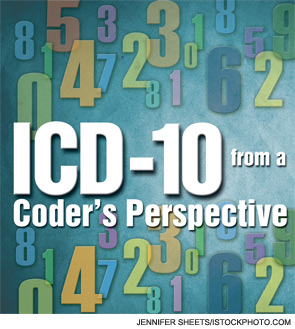
For the past 30 years, coders have used the International Classification of Diseases, Ninth Revision (ICD-9) to identify and report diseases, signs, and symptoms as well as to measure morbidity and mortality in the United States. In general, coders identify ICD-9 as the heartbeat of reimbursement for medical procedures because this is what drives medical necessity.
The 2009 announcement of the new code set was received by coders with excitement as well as anxiety, given the vast increase from about 14,000 codes in ICD-9 to approximately 68,000 codes in ICD-10.
“Having more specific codes to choose from with much more specificity will be a great benefit to our physicians,” says Candice Brazeale, CPC, CRHC. Brazeale is the coder for Piedmont Arthritis Clinic in Greenville, S.C., and oversees the coding and billing for four rheumatologists and one nurse practitioner. She notes that it will take time to become familiar with the new codes but that the transition is unavoidable. Brazeale suggests that coders take the year and a half until the new codes go into effect to prepare.
Coders have always looked for new and expanded codes each year to identify illnesses or viruses that are encountered in the physician office or hospital. The use of unspecified or “not elsewhere specified” is a normal coding scenario for many specialties because no other specific code is available to identify the diagnosis listed in the medical records.
“ICD-10 has an improved structure for this new code set, and the specificity in the codes will make it much easier for practices to find the correct codes, especially for rheumatology,” says Antanya Chung, CPC, CPC-I, CRHC, CCP, director of practice management for the ACR.
“Changing from ICD-9 to ICD-10 will affect every aspect of rheumatology practices nationwide,” says Chung. “Preparation is the key for implementation, and physicians and their practice staff should begin the groundwork now.” That said, Chung thinks that the organization and layout of ICD-10 is much better. There are now 21 chapters in ICD-10, compared with 19 chapters in ICD-9. One major change is the expansion of the musculoskeletal and connective tissue section, which now has more specificity and laterality that will make it much easier for rheumatology practices to code to the highest level.
Most coders feel that the new codes will open the door for education and training on documentation guidelines for physicians. “Documentation is the key to coding correctly and with more specificity in ICD-10. Physicians should see fewer denials for medical necessity after the initial phase-in of ICD-10,” says Melesia Tillman, CPC, CRHC, CHA, the ACR coding and reimbursement specialist. The denial rate for medical necessity should fall tremendously with the adoption of ICD-10, as long as physicians and staff are appropriately trained to use the new code set, so training will be very important.
ICD-10 Training
There are similarities and differences between ICD-9 and ICD-10. Similarities include the hierarchal structure, the meanings of the symbols, and the criteria for code assignment of the principal diagnosis code. Coders should always remember the general rule of coding: Never to code from one section only! Both the tabular and alphabet index should be used when coding, and this is still the rule in the ICD-10 code set.
The biggest difference between the two code sets is the structure of the codes. The ICD-10 code set is up to seven alphanumeric characters, while ICD-9 only has three to five characters. Also, the “V” and “E” codes from ICD-9 will no longer exist. The sixth digit in ICD-10 will mainly be numeric and will identify laterality and drug poisoning. Information technology and practice management software in practices will be greatly affected. The volume of codes will be greater and the code descriptors will be different. Systems will have to be updated to properly identify the new codes—and this means significant training will be necessary for physicians, coders, and other nonphysician health professionals.
Start Planning Now
Rheumatology practices should purchase a draft copy of the ICD-10 manual so staff can become familiar with the codes. Also, cross-training staff will play a vital role in making the transition to ICD-10. Anticipate disruption to reimbursement due to rejections and denials while systems are being crossed over to the new code set. Also expect a higher-than-usual number of appeals and refiled claims because ICD-9 codes will still be used for the first nine months of 2013. Now is a good time for practices to cross-train staff to help the practice weather the transition.
It is important for all coders to have the necessary training and education for ICD-10. Coders who hold a coding membership from the AAPC will have to take a proficiency exam for ICD-10 beginning October 1, 2012. Coders will have two years to pass the exam, which will test the ability to code using the new code set. The exam will consist of 75 questions and will be available online. Contact the AAPC for more information on the proficiency exam.
How the ACR Can Help You Prepare
With only two years until the compliance date, the ACR is taking steps to prepare rheumatologists and their staff for ICD-10. A variety of resources such as webinars, audio conferences, and coding presentations will be available for members. In addition, there will be an ICD-10 practice session during the 2011 ACR/ARHP Annual Scientific Meeting in Chicago.
The ACR understands that this will not be an easy process and it will provide education and training to prepare rheumatologists and their staff to meet the October 1, 2013, compliance date for ICD-10. Currently, ACR coders are creating a crosswalk for the most common rheumatology codes and will make this available on the ACR website along with other resources and tools. As a first step, providers should appoint a point person take the lead and guide the practice through the implementation process. Keep in mind that while practices have two years to prepare, it’s important to make every moment count.
Be sure to read “Plan Now for ICD-10 Changeover” and “2013–A Whole New World” for more information on getting ready for ICD-10. If you have questions related to ICD-10 or coding and reimbursement, contact the ACR’s practice management department at (404) 633-3777 or [email protected]. Or, join the ACR coding list serve at www.rheumatology.org/membership and post your questions online.
